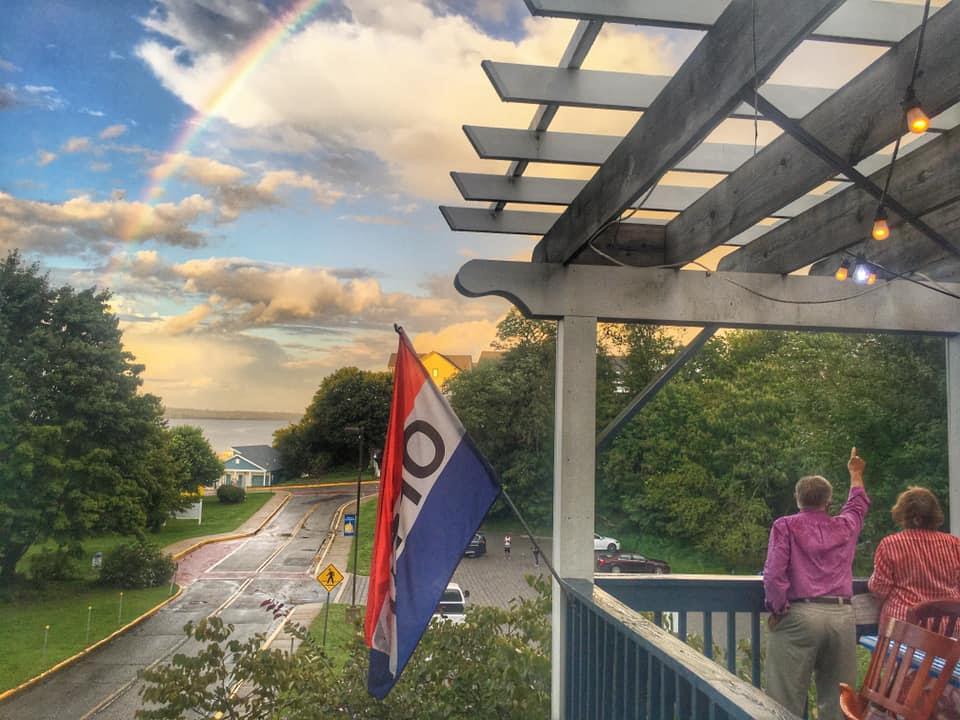Ever since Judy Garland—sorry, I mean Dorothy—showed us there really was a place somewhere over the rainbow, we’ve marveled at those dazzling arcs of color in the sky. Actually, our fascination with rainbows is even older than Oz; Genesis old, in fact. Remember? In the aftermath of the great flood, God made a promise to Noah and his sons: “I have set my rainbow in the clouds, and it will be a sign of the covenant between me and the earth. Whenever I bring clouds in the earth and a rainbow appears in the clouds, I will remember my covenant with you and all living creatures of every kind. Never again will the waters become a flood to destroy all life.” (Genesis 9: 12-15)
That’s the spirituality of rainbows. The science of rainbows is quite different. Think ROYGBIV: red, orange, yellow, green, blue, indigo, and violet. These prismatic colors are the result of a meteorological phenomenon caused by the reflection, refraction, and dispersion of light found in suspended droplets of water in the atmosphere. Under the right conditions, these water droplets form an arc in a section of the sky always directly opposite the sun. But guess what: as visible as they are, rainbows aren’t real; they’re fake news, mere optical illusions caused when all those droplets of water are viewed from a certain angle (about 42 degrees) relative to a light source. And therein lies the sad truth about rainbows: they aren’t real, they can’t be touched or even physically approached. Like a mirage, they hover in a space removed from us, a sublime trick of water and light that seduces us into belief. Maybe that’s where science and spirituality converge: somewhere over the rainbow.
Many cultures have rainbow legends. In Ireland, most of us know the one about a fabled pot of gold at the rainbow’s end, watched over by mischievous little green leprechauns. In Norse mythology, a rainbow is the bridge between this world and the world to come, the final crossing to our home in the sky. In Hindu culture, the rainbow is an archer’s bow that can shoot arrows of lightening while to the Chinese, it’s a crack in the sky made by stones cast by the mother goddess, Nüwa. What a fistful of fanciful legends generated by a just few tiny droplets of water suspended in the atmosphere, colored by sunlight!
But wait: there’s more! It took a physicist of the ilk of Sir Isaac Newton to postulate an interesting link between the seven colors of the rainbow and the seven notes of the Western musical scale. He imagined a subtle and gradual change in vibrations along the spectrum of visible light that bled one color into another, similar to the changes in frequency that move us along the Do-Re-Mi highway. More science, more art, more wonder. Even with all that’s going on these days, you’ve got to admit: what a wonderful, albeit sometimes illusory, world we inhabit!
So, what’s the takeaway? Why this sudden interest in a place where happy little bluebirds fly, a land that we heard of once in a lullaby? Just this: several days ago, six good friends were seated around an outdoor table on the deck at one of our favorite local restaurants. It was a lovely cool evening, the food and conversation were great when suddenly, a passing shower sent us scurrying under the eaves, napkins on our heads, holding our plates close to keep them dry. But the shower was over in a heartbeat and in its wake, a rainbow appeared. Enthralled, we fell silent and watched the sky color and clear, and in that instant, everything else—the pandemic and the politics and all the social upheaval of the day—was forgotten as six good friends stood in wonder, observing the science and the splendor above us, somewhere over the rainbow.
Why-oh-why can’t we all?
I’ll be right back.
Jamie Kirkpatrick is a writer and photographer with a home in Chestertown. His work has appeared in the Washington Post, the Baltimore Sun, the Philadelphia Inquirer, the Pittsburgh Post-Gazette, the Washington College Alumni Magazine, and American Cowboy Magazine. Two collections of his essays (“Musing Right Along” and “I’ll Be Right Back”) are available on Amazon. Jamie’s website is www.musingjamie.com




Evan Thalenberg says
I love the way Jamie takes something we all see and, through research and thought, looks at it from different cultural and historic angles to give us a new perspective
and appreciation. These essays are uplifting and welcome.
Leslie Moorhouse says
Again……..knocked out of the park!! Great shot from Barbara’s deck!
Keep ’em coming!!